Gigabyte GA-EP45-UD3P - P45 at its Finest
by Gary Key on February 3, 2009 12:15 AM EST- Posted in
- Motherboards
Software
GIGABYTE provides several software applications with the GA-EP45-UD3P, EasyTune6 and D.E.S Advanced being the two main ones.
EasyTune6
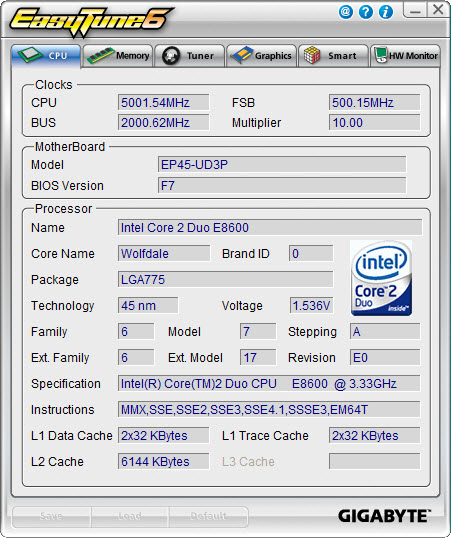
GIGABYTE's EasyTune6 application provides monitoring, system information, and overclocking capabilities. This is one of the best applications provided by the various motherboard suppliers for tuning a system within Windows. We would still like to see additional voltage readings and the ability to save the settings to the BIOS - or at least a BIOS profile. Other than that, this application is useful for extracting a decent amount of performance improvement out of the system after booting Windows. One benefit of such an approach is that you can reduce performance - along with power requirements and the stress on a system - without rebooting.
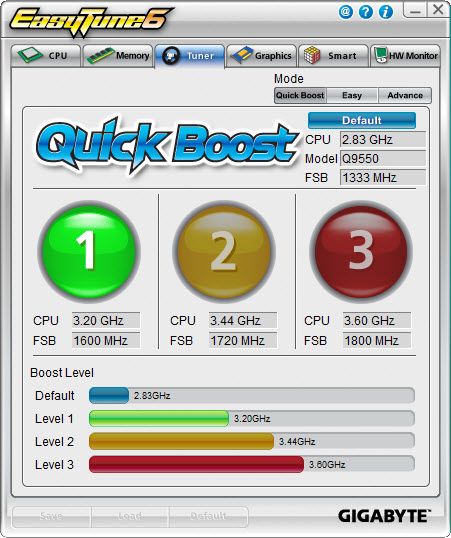
Quick Boost mode is a new feature that GIGABYTE introduced along with Ultra Durable 3 on their motherboards. It is a simple way for novice users to quickly overclock their systems without entering the BIOS. Once you click on one of the three boost levels, the utility will automatically optimize system settings according to your specific hardware combination. The program is based on algorithms of hardware that has been pre-tested by GIGABYTE engineers.
We tried about twenty-five different hardware combinations and 24 out of the 25 worked correctly. While not perfect, it was commendable that a majority of hardware combinations worked as advertised. GIGABYTE is constantly updating the application for product compatibility. Our testing indicates that users with recently purchased hardware will not have any trouble with Quick Boost.
The combination that did not work properly happened to be with our standard test setup today. On the first setting, we wanted to take our 2.83GHz Q9550 to 3.2GHz. Sounds simple right? We hit the first boost level, rebooted, and Vista loaded without a problem. We checked our settings and sure enough, the system was operating at 3.2GHz with an 8x CPU multiplier, 400FSB, memory set to DDR2-1066 at 5-5-5-15. Voltages were all set to stock except VDimm was increased to 1.9V per the SPD. We started our first benchmarks and the system crashed. It crashed repeatedly as a matter of fact. The problem is that Quick Boost set the FSB strap (MCH Latch) from 333 to 200 in order to run the memory at 1066. However, it did not raise the MCH voltages to compensate for the additional load on the memory controller.
We sent in a trouble ticket to GIGABYTE Technical Support. We received a standard reply that overclocking is not guaranteed even though we more or less laid out the problem for them. This was the one time we had a problem with technical support. Our other technical support tests ranging from flashing the BIOS to enabling SpeedStep were answered correctly. We ended up escalating this problem to the Technical Marketing Group and within 24 hours we had a new BIOS delivered to our in-box that fixed the problem. Our FSB strap stayed at 333 and the memory was set to DDR2-800 on the 1:1 ratio with 4-4-4-12 timings per the SPD.
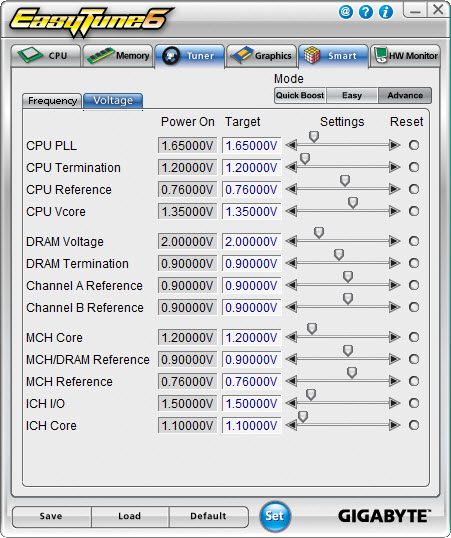
For those who appreciate and want a manual approach to overclocking, the Tuner tab has two different options. Easy mode allows control over the front side bus, but it is Advance mode that opens a slew of on-the-fly tweaking options that actually work. You can adjust the front side bus, processor multiplier, memory multiplier, PCI-E frequency, and numerous voltage options.
We have to say that using EasyTune6 was a pleasure. We repeatedly loaded this application first after getting the OS installation up and running. ET6 is definitely a huge help in tweaking those final settings to find a motherboard's overclocking limits.
DES
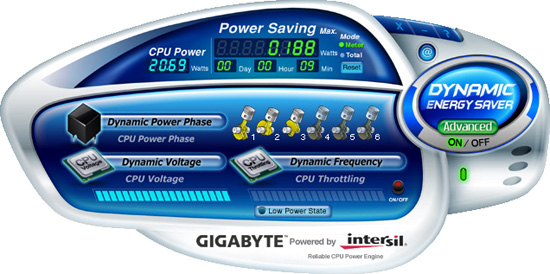
One of the most highly touted features from GIGABYTE is their Dynamic Energy Saver (DES) advanced power management solution. GIGABYTE provides a Windows-based software application to control DES. After installing the software (we highly suggest downloading the latest version) and a quick reboot, the application is ready for use. The control panel is powered down by default and it is up to the user to turn it on with a simple click of the DES button.
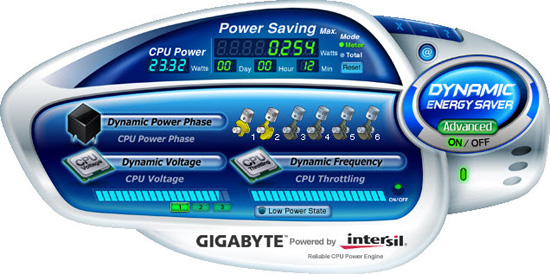
The DES software is simple to use and easy to understand. GIGABYTE provides a power savings meter in the top portion providing us with power savings information that can be reset at startup; otherwise it will track the power savings since the installation of the product. Real-time CPU power usage is available along with a graphic representation of the phases in use. You can also enable CPU throttling to save additional power during operation. GIGABYTE also includes an onboard LED system that indicates the number of phases in use. These LEDs can be turned on and off from the control panel. The user can also utilize DES while the system is overclocked, something most power saving programs do not allow.
















73 Comments
View All Comments
Nickel020 - Saturday, February 14, 2009 - link
Gary,many people including someone who posted here in the comments have the problem that the board won't boot in dual channel but everything is perfectly stable in single channel and the RAM sticks have all been verified to be working.
Did you experience this problem when reviewing the board? The standard Gigabyte tech support guy has no clue how to fix this problem :( Could you maybe contact someone at GB to see if they're aware of this issue and if there is a fix for it?
Would be great if you could do that!
Thanks!
Nickel020 - Saturday, February 14, 2009 - link
I've been working on it and it seems that the RAM runs fine in single channel mode and slots 1 & 2.Trying DIMM clock skew now to check whether this may fix it.
GhettoFly - Wednesday, February 11, 2009 - link
DFI's UT P45-T2RS isn't getting a lot of press coverage, but it's making some noise on enthusiast forums. Given Anandtech's excellent articles in the past on DFI boards, I was just curious if you guys planned to take a look at it, or was this Gigabyte the last P45 board you're going to review?The0ne - Tuesday, February 10, 2009 - link
I have the EP45-DS3R and it performs very well. I have the Q6600 up to 3.42Ghz with ST 800Mhz memory. OC much better than the dead IP35E MB it replaced and I had thought I bought a lower performing board since it cost me $95 at frys :)Believer - Monday, February 9, 2009 - link
I'm personally having major issues with this board and with my set of 4x2048MB OCZ Reavers.But then I don't receive cherry-picked products or have a hot-line to their tech support either.
Reading up on a quite a few tech forums now have shown me I'm far from the only one with similar issues too.
I suffer from the endless reboot cycling, the inability to boot with 4 memory modules installed and nonworking dual-channel support at either default, fail-safe or optimized BIOS settings.
Upgrading BIOS to F7 didn't solve anything either.
In order to get anything booted up I need to first install only 1 memory module, change in BIOS with upped Voltages to the MCH and DRAM, lower the FSB and/or memory to 800 and up the latencies.
With such a change I can boot with all 4 of my Reavers installed.
Yey...
I have a friend with this board and Reaver memory too, and he can't OC the board the slightest without it crashing... not even slightly past the default PC2-1066 memory speeds, with FSB 333. But he doesn't have the other basic memory issues I'm having though. His and mine CPU temperature readings are low into the 30ish degree Celsius area too.
Oh, and I might add I'm into my second RMA of the board without much of an improvement. The 2 boards showed two very different kind of memory issues though. But my memory runs just fine as long as I install them one and one, or 2 without dual channel config, I've stress tested them endlessly on default settings like that without problems.
Anyone with similar issues that know what could be the fault?
I have not get any response from Gigabyte's own tech support regarding this. Me and a few others with similar issues are being ignored on one of their own official support threads. That's service...
I'm having a tech support from OCZ to help me sort out the problems too however, but he's leaning that it would seem to be my boards fault... again.
Seem like third RMA might be getting closer.
... or I sit and drum my fingers waiting for Gigabyte to finally address the issues.
Jynx980 - Friday, February 13, 2009 - link
Mine wouldn't even boot up. The CPU fan would not spin. A couple of other people on the Newegg reviews mention this problem also. How long did it take you to get your RMA approved? Mine is still "open" after a week. Tech support was ok. It took a couple of days but they did respond. Also haven't heard anything about the mail in rebate, and that's been about a month. I sent in a mushkin rebate on the same day to the same rebate center and I already have gotten the check.syseng - Friday, June 12, 2009 - link
Gigabyte is obviously having financial problems. After 4 months, I do not have the rebates for my motherboard or graphics card. The companyhandling the rebates said Gigabyte has not released rebate checks in "quite a while". Resellers like Newegg should just drop them if they are not going to honor their commitments.Isme - Thursday, December 3, 2009 - link
Gigabyte has had "financial" problems for 15 years. Quality has varied from time to time though it has usually been cases of bad engineering rather than bad workmanship.I think the "financial" problems aspect is that they are just cheap skates who intend that if anyone gets shafted on a deal it won't be Gigabyte. That is to say that direct exchanges have never been pleasant for private individuals. You really want to be buffered through a retailer or wholesale who is doing mass returns...or be an important reviewer...or just very patient.
Believer - Monday, February 9, 2009 - link
Correct that, I just got a generic response from one of Gigabyte Tech Support.Looks like they're trying to pin-point it to the memory modules as no ordinary combination of 2 memory pairs are ever specifically supported to work together.
Isme - Thursday, December 3, 2009 - link
Hmmm...does that mean the board really only supports a single dual channel pair? That would mean the other 2 slots are basically there is nice looking decoration only.Or was that response simply saying that Gigabyte never tested the motherboard with all 4 slots filled with off-the-shelf memory rather than hand-picked laboratory measured memory modules? Thus their answer could be more accurately paraphrased "we haven't got a clue and its your problem now sucker". With the whole overclocking fad I can sort of see this as a corporate answer (HObbyist know as much as we do and are willing to spend time -- so why should we waste our time providing a solution).
Still it would be nice if they proved their claims using at least a couple sets of stock hardware in an non-overclocked configuration BEFORE releasing and advertising to the general public.